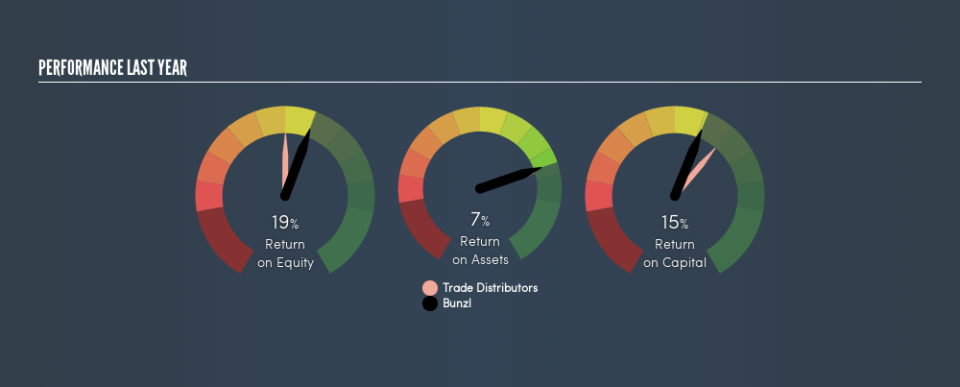Should You Care About Bunzl plc’s (LON:BNZL) Investment Potential?

Today we’ll evaluate Bunzl plc (LON:BNZL) to determine whether it could have potential as an investment idea. Specifically, we’ll consider its Return On Capital Employed (ROCE), since that will give us an insight into how efficiently the business can generate profits from the capital it requires.
First of all, we’ll work out how to calculate ROCE. Next, we’ll compare it to others in its industry. And finally, we’ll look at how its current liabilities are impacting its ROCE.
What is Return On Capital Employed (ROCE)?
ROCE measures the amount of pre-tax profits a company can generate from the capital employed in its business. Generally speaking a higher ROCE is better. Overall, it is a valuable metric that has its flaws. Author Edwin Whiting says to be careful when comparing the ROCE of different businesses, since ‘No two businesses are exactly alike.’
How Do You Calculate Return On Capital Employed?
Analysts use this formula to calculate return on capital employed:
Return on Capital Employed = Earnings Before Interest and Tax (EBIT) ÷ (Total Assets – Current Liabilities)
Or for Bunzl:
0.15 = UK£502m ÷ (UK£5.6b – UK£2.1b) (Based on the trailing twelve months to December 2018.)
So, Bunzl has an ROCE of 15%.
Check out our latest analysis for Bunzl
Does Bunzl Have A Good ROCE?
ROCE is commonly used for comparing the performance of similar businesses. We can see Bunzl’s ROCE is around the 15% average reported by the Trade Distributors industry. Regardless of where Bunzl sits next to its industry, its ROCE in absolute terms appears satisfactory, and this company could be worth a closer look.
When considering ROCE, bear in mind that it reflects the past and does not necessarily predict the future. ROCE can be deceptive for cyclical businesses, as returns can look incredible in boom times, and terribly low in downturns. ROCE is, after all, simply a snap shot of a single year. Since the future is so important for investors, you should check out our free report on analyst forecasts for Bunzl.
Bunzl’s Current Liabilities And Their Impact On Its ROCE
Liabilities, such as supplier bills and bank overdrafts, are referred to as current liabilities if they need to be paid within 12 months. The ROCE equation subtracts current liabilities from capital employed, so a company with a lot of current liabilities appears to have less capital employed, and a higher ROCE than otherwise. To counteract this, we check if a company has high current liabilities, relative to its total assets.
Bunzl has total assets of UK£5.6b and current liabilities of UK£2.1b. As a result, its current liabilities are equal to approximately 38% of its total assets. With this level of current liabilities, Bunzl’s ROCE is boosted somewhat.
The Bottom Line On Bunzl’s ROCE
With a decent ROCE, the company could be interesting, but remember that the level of current liabilities make the ROCE look better. But note: Bunzl may not be the best stock to buy. So take a peek at this free list of interesting companies with strong recent earnings growth (and a P/E ratio below 20).
If you like to buy stocks alongside management, then you might just love this free list of companies. (Hint: insiders have been buying them).
We aim to bring you long-term focused research analysis driven by fundamental data. Note that our analysis may not factor in the latest price-sensitive company announcements or qualitative material.
If you spot an error that warrants correction, please contact the editor at editorial-team@simplywallst.com. This article by Simply Wall St is general in nature. It does not constitute a recommendation to buy or sell any stock, and does not take account of your objectives, or your financial situation. Simply Wall St has no position in the stocks mentioned. Thank you for reading.

 Yahoo Finance
Yahoo Finance 
